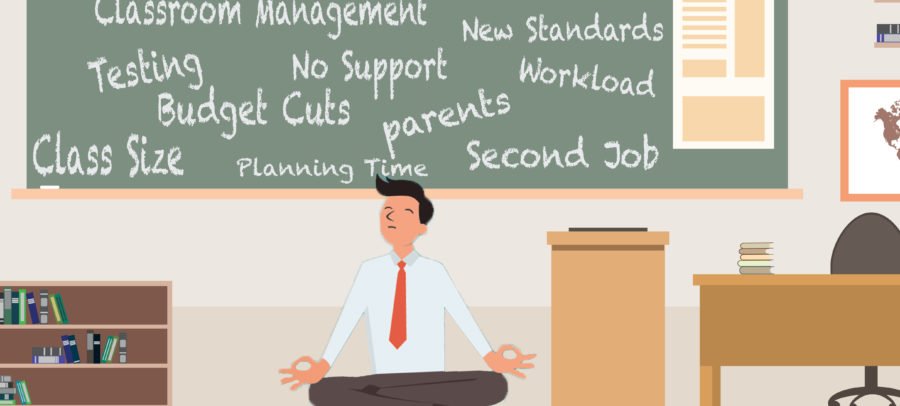Everyone knows that teaching is one of the most demanding and stressful professions. And most are probably aware that a majority of teachers are feeling a high level of stress. Still, we may have been underestimating the magnitude of the problem, according to a new study by the University of Missouri (MU).
Keith Herman and Wendy Reinke, both professors in the MU College of Education, and doctoral student Jal’et Hickmon-Rosa found that 93 percent of elementary school teachers report that they are experiencing a high stress level. The study was recently published in the Journal of Positive Behavior Interventions.
The researchers asked 121 teachers who taught kindergarten through 4th grade in an urban Midwestern school district to complete self-report measures on their levels of burnout, stress, efficacy, and coping. The teachers were asked such questions as "How stressful is your job?" and “How well are you coping with the stress of your job right now?” The researchers then linked the resulting data to the behavioral and academic outcomes of their students. They found that high teacher stress levels were usually associated with poorer student results, such as lower grades and frequent behavior problems.
In the study, educators with low levels of stress and high coping ability were practically non-existent.
While Herman wasn't surprised that most teachers feel stressed in their jobs, he didn't expect that "only 7 percent rated themselves as having both low levels of stress and high levels of coping with their jobs." (Herman and his colleagues are finding similar results in a yet-to-be-completed follow-up study with middle school teachers.)
The University of Missouri study, while generally corroborating previous research about the job pressures educators face and the potential impact on students, brings something new to the table. "We could find no other study that simultaneously examined teacher stress and coping levels. While stress and coping are related to each other, they are distinct constructs," Herman says.
Focusing on how educators succeed or fail at "coping" with job pressures can be misconstrued as placing the blame squarely on those individuals. Talking too much about "burnout," for example, implies that many teachers simply can't hack it in the classroom and it's ultimately up to them to make the necessary changes. Doris Santoro of Boiwdon College believes teachers are just as "demoralized" by a changing profession as they are "burned out" by its demands. Schools, communities and policymakers, therefore, are all responsible for restoring what has been stripped from the profession.
I’m surprised that few people seem to connect the dots back to their own children. When I think of my daughter, I know that I don’t want her to spend an entire day with an adult who is feeling overwhelmed, under-appreciated, and mistreated.”
Herman agrees. The stress level felt by educators is a wake-up call to the country about the state of the profession, but supporting their use of effective coping strategies must be part of the solution - and educators recognize this.
Herman recalls the reaction of a group of teachers he was training in classroom management intervention a few years ago. After outlining basic coping principles to stress management on the board, Herman turned around to the class and saw the participants "feverishly taking notes," he recalls. "I was struck by how many teachers had not been acquainted with this very useful approach to coping with inevitable life stressors." Herman, with Reinke, co-wrote "Stress Management for Teachers: A Proactive Guide," published by Guilford Press in 2014.
While individual coping matters, real, sustainable success is unlikely without a comprehensive school-wide commitment to create healthier and productive climates for staff and students.
"Administrators set the tone in their building for how teachers are perceived and supported. Prioritizing teacher well-being and giving higher rates of recognition and positive feedback to teachers versus criticism and judgment helps set a positive tone," Herman explains.
More broadly, improved workplace conditions, greater autonomy in the classroom, and a voice in decision-making can also go a long way in giving teachers the professional respect that is so pervasive in high-achieving countries.
The recent strikes and walkouts of educators in West Virginia, Oklahoma, Arizona, and Colorado has forced the nation to take a hard look at not only the underfunding of public education, but also how their profession has been denigrated. This kind of national attention, says Herman, can help society acknowledge that undervaluing the teaching profession harms students.
"I'm surprised that few people seem to connect the dots back to their own children. When I think of my daughter, for instance, I know that I don’t want her to spend an entire day with an adult who is feeling overwhelmed, underappreciated, and mistreated," Herman explains. "That’s a bad setup for everyone. I hope we are calling attention to the fact that teachers need our support, as parents, as community members, as policy makers, and as private citizens. When teachers are neglected, our children are neglected."









